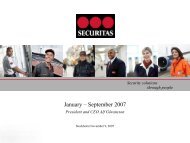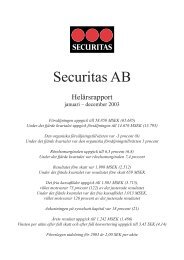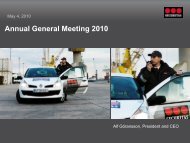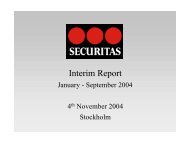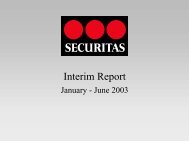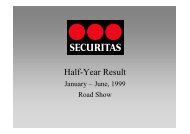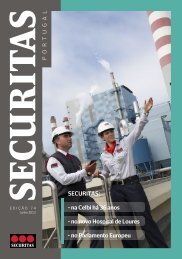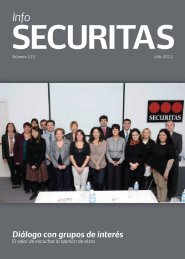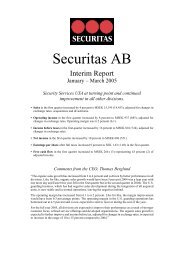NO. 1 2010 - Securitas
NO. 1 2010 - Securitas
NO. 1 2010 - Securitas
Create successful ePaper yourself
Turn your PDF publications into a flip-book with our unique Google optimized e-Paper software.
solving any of these problems<br />
begins with a big<br />
picture view of the global<br />
risks that your business faces,<br />
and a system of continuous<br />
security management practices<br />
that match quality programs.<br />
While this may seem obvious,<br />
Bruce Wimmer, CPP, director of<br />
Consulting, Pinkerton Consulting<br />
& Investigations (C&I) suggests<br />
that the idiosyncrasies of global<br />
transactions often create mazes<br />
and mysteries, making continuous<br />
quality control next to impossible.<br />
“Global corporations need a secure<br />
supply chain to help protect their<br />
assets and profitability,” says<br />
Wimmer. Once it is realized<br />
that ongoing success depends<br />
on well-trained employees and<br />
suppliers having the means to<br />
identify threats at their point of<br />
origin, or weak links in the chain,<br />
you are already ahead.<br />
“Our job is to help top management<br />
meet or exceed their<br />
objectives and sleep soundly<br />
at night, because security is<br />
continuously evolving for the<br />
better all along the chain,”<br />
Wimmer continued.<br />
progress at<br />
the point of origin<br />
If your business imports products,<br />
finished goods, components or<br />
parts into the United States that<br />
are critical to your operations,<br />
you should become an active<br />
partner with the U.S. government<br />
under the Customs-Trade<br />
Partnership Against Terrorism<br />
(C-TPAT) program. Pinkerton C&I<br />
has been a part of the C-TPAT<br />
program since its inception and<br />
because of this association is<br />
uniquely qualified and experienced<br />
in assisting businesses<br />
that want to participate in the<br />
C-TPAT program.<br />
According to Carl Roe, manager,<br />
Global Supply Chain Security<br />
with Pinkerton C&I, who held<br />
senior positions with U.S.<br />
Customs for over 35 years,<br />
“Border control took a decisive<br />
leap ahead when we realized<br />
that national boundaries are<br />
best protected when the focus<br />
moves to the supply chain<br />
before the U.S. border, starting<br />
at the point of origin. When<br />
systems and procedures to<br />
protect your products, your<br />
people, and your customers<br />
originate at the starting point,<br />
it’s only logical that you have<br />
fewer worries at the border.<br />
Just as the right packaging is a<br />
critical asset in the protection of<br />
goods, the right security package<br />
is equally valuable.”<br />
Pinkerton C&I is a good fit for<br />
U.S.-based global companies,<br />
large and small, as their partner<br />
in the C-TPAT and as a comprehensive<br />
supply-chain security<br />
resource. They also play an<br />
active role in the World Customs<br />
Organization (WCO) efforts to<br />
standardize supply chain<br />
security requirements, and<br />
recognition of foreign supply<br />
chain security programs, such<br />
as the Authorized Economic<br />
Operator (AEO) initiatives.<br />
“For a modest investment,<br />
smaller customers gain from<br />
our broad range of experience<br />
developed on behalf of major<br />
corporations,” explains Roe.<br />
“Since 9/11, remarkable progress<br />
has been made in keeping<br />
weapons of mass destruction<br />
and terrorists from potentially<br />
disrupting commerce and<br />
normal life in American cities,”<br />
Roe continues. “In only eight<br />
years the C-TPAT has brought<br />
together government, law<br />
enforcement, businesses,<br />
bruce Wimmer’s<br />
Management tips<br />
to sleep soundly<br />
y Know and evaluate all potential threats; the<br />
effectiveness of existing security (vulnerability);<br />
and potential adverse business impact<br />
(consequences) — know the risk.<br />
y Determine appropriate security approaches that<br />
are risk-based.<br />
y Know all your business partners — up and down<br />
the supply chain.<br />
y Require all partners to comply with minimal<br />
security standards.<br />
y Audit partners and their partners — know how well<br />
they comply.<br />
y Conduct financial due diligence.<br />
y Focus on people — with tailored education and<br />
awareness training programs that let people know<br />
what is expected of them, what to watch for and<br />
how to report concerns.<br />
y Do background investigations.<br />
y Have good physical security … including access<br />
control and thorough audit trails of everyone<br />
entering/exiting a facility/complex.<br />
y Use technology as a tool, but do not expect<br />
technology to solve all issues.<br />
y Document and constantly track all conveyances<br />
used in transport; have redundant methods to<br />
immediately detect a problem; build in delay<br />
mechanisms; have an ability to respond to<br />
any problem.<br />
y Build redundancy into your supply chain<br />
process and ensure business continuity issues<br />
are addressed.<br />
WWW.securitasinc.coM 23



